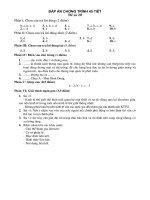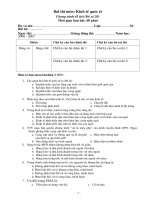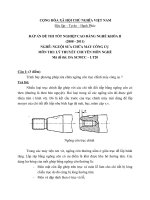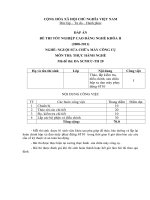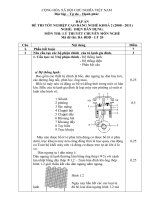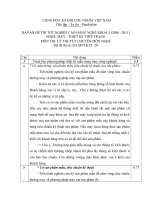20 hydrozirconation final 0
Bạn đang xem bản rút gọn của tài liệu. Xem và tải ngay bản đầy đủ của tài liệu tại đây (889.6 KB, 11 trang )
Myers
Hydrozirconation and Carbozirconation
Chem 115
Reviews:
• Metallocenes in regio- and stereoselective synthesis, Vol. 8, Takahashi, T. Ed.; Springer: Berlin;
New York, 2005.
• Marek, I.; Chechik-Lankin, H.; Functionalized Organozirconium and Titanium in Organic
Synthesis, in Handbook of Functionalized Organometallics: Applications in Synthesis, Knochel, P
Ed.; Wiley-VCH: Weinheim, 2005.
• Hydrozirconation proceeds by a stereospecific, concerted 4-centered process that typically
places zirconium on the less-substituted carbon.
• The relative rates of hydrozirconation for different substrates are as follows:
>
R
General Reactivity of Zirconocene Compounds
R
R2
~
R1
>
R1
R2
R2 ~
R2
>
R1
R1
R3
• Selective hydrozirconations have been reported:
Zr
Y
Zr
X
Generalized
zirconocene
Cl
H
Cp2ZrHCl
Zirconocene
hydrochloride
(Schwartz's reagent)
81%
Fryzuk, M. D.; Bates, G. S.; Stone, C. J. Org. Chem. 1991, 56, 7201–7211.
• Zirconocene complexes of the formula Cp2ZrXY are 16-electron d0 Zr(IV) complexes with one
empty valence shell orbital available for coordination. Consequently, many reactions of these
compounds are initiated by the interaction of an electron donor such as the π-bond of an olefin with
the empty Zr orbital.
Cp Cp
Zr
H
C6H6, 23 °C
>56%
X
C C
C C
bonding
backbonding
Crombie, L.; Hobbs, A. J. W.; Horsham, M. A.; Blade, R. J. Tetrahedron Lett. 1987, 28, 4875–
4878.
• Neighboring groups can influence the site of zirconation:
Cp2ZrHCl
• Treatment of alkenes and alkynes with zirconocene hydrochloride gives rise to alkyl- and
alkenylzirconium intermediates, respectively.
R2
R1
Zr
H
Cl
hydrozirconation
R1=alkyl, aryl; R2=alkyl, H
ZrClCp2
R2
OK
THF, 23 °C
Cp2Zr O
H3C
Takaya, H.; Yamakawa, M.; Mashima, K. J. Chem. Soc., Chem. Commun. 1983, 1283–1284.
H
dehydrozirconation
R2
R1
TMS
Zr
Hydrozirconation
R1
ZrCp2Cl
Cp2ZrHCl
TMS
Cp Cp
ZrCp2Cl
toluene, 23 °C
R1
ZrClCp2
H
R2
Claudia Kleinlein, Matt Mitcheltree
1
Myers
Hydrozirconation and Carbozirconation
• CH3Li–ZnCl2 reverses the regioselectivity in hydrozirconation of propargylic alcohols. The authors
propose that alkoxide generation with CH3Li promotes directed hydrometalation, while ZnCl2
blocks isomerization to the thermodynamically favored linear vinylzirconium species.
OH
R
• Isomerization presumably occurs via a dimetalated species:
RL
RS
1. Cp2ZrHCl (2 equiv)
THF, 23 °C
OH
I
R
2. I2, DCM, –78 °C
without additive
MeLi (1 equiv), ZnCl2 (6 equiv)
H
H
I
R
linear
branched
> 50
1
1
> 50
CH3
• If the thermodynamic product is desired, however, equilibration can be achieved by treatment with
additional hydrozirconation reagent.
Cp2ZrHCl
H3C
H
Cl
RL
+
RS
Zr
Cl
RS
Cp2ZrHCl
ZrCp2Cl
H
RS
• Similarly, internal alkenes undergo rapid isomerization at room temperature to terminal alkenes
via β-H-elimination of the initially formed alkyl zirconium intermediate, followed by re-addition. By
contrast, considerably higher temperatures are required for alkene isomerization in
hydroalumination and hydroboration reactions.
Zhang, D.; Ready, J. M. J. Am. Chem. Soc. 2007, 129, 12088–12089.
Zr
RL
H
ClCp2Zr
ZrCp2Cl
ClCp2Zr
OH
+
Chem 115
Zr
Cl
RL
Cl
Zr
CH3
CH3
H3C
CH3
quantitative
C6H6, 23 °C
H
H
RL
1
RS
RL
Initially
observed
after treatment with
Cp2ZrHCl
H
n-Bu
> 98 : 2
ND
Et
55 : 45
Hart, D. W.; Schwartz, J. J. Am. Chem. Soc. 1974, 96, 8115–8116.
2
Product ratio 1 : 2
CH3
RS
89 : 11
CH3
n-Pr
69 : 31
91 : 9
CH3
i-Bu
55 : 45
> 95 : 5
CH3
i-Pr
84 : 16
> 98 : 2
CH3
t-Bu
> 98 : 2
ND
Reactions of organozirconocene compounds
Review: Wipf, P.; Jahn, H. Tetrahedron 1996, 52, 12853–12910.
• Due to steric crowding around zirconium, only small electrophiles react with organozirconocenes.
R2
R1
transmetalation
H
Cl
Zr
R1
R2
R1
M-X
M
H
oxidation or
halogenation
quench with D2O
X C:
R2
R1
H
C
R2
carbenoid
insertion
R2
R1
H
D
Hart, D. W.; Blackburn, T. F.; Schwartz, J. J. Am. Chem. Soc. 1975, 97, 679–680.
C–C
coupling
H
X
Zr
Cl
X
H
R1
R2
Claudia Kleinlein, Matt Mitcheltree
2
Myers
Hydrozirconation and Carbozirconation
Oxidation
• A number of reagents are capable of oxidizing alkylzirconocenes to the corresponding linear
alcohols. These methods do not apply to alkenylzirconocenes.
•
In the following table, n-octylzirconocene chloride (R = n-Hex) was obtained by hydrozirconation–
isomerization of a mixture of linear octenes (vide supra).
Chem 115
• 1,1-Bimetallic reagents of zirconium and boron can be prepared in situ and converted into
valuable building blocks. In the example shown, α-zirconation occured exclusively.
ZrCp2Cl
Cp2ZrHCl
n-Bu
n-Bu
B(pin)
Zr
n-Bu
B(pin)
DCM, 23 °C
Br
NBS
B(pin)
Conditions
Cl
HO
98%
R
R
Zheng, B.; Srebnik, M. Tetrahedron Lett. 1994, 35, 1145–1148.
R
Conditions
Yield
t-Bu
O2; H2O
91%
isopropenyl
O2; H2O
77%
n-Hex
H2O2, NaOH
69%
n-Hex
t-BuOOH
72%
n-Hex
m-CPBA
45%
n-Hex
CrO2Cl2
52%
• High regioselectivity is observed in the hydrozirconation of alkynyl stannanes as well:
SnBu3
Cp2ZrHCl, THF
ZrCp2Cl
BnO
I2, 0 °C
I
BnO
SnBu3
SnBu3
23 °C, 15 min
OBn
90%
Lipshutz, B. H.; Keil, R.; Barton, J. C. Tetrahedron Lett. 1992, 33, 5861–5864.
Hart, D. W.; Schwartz, J. J. Am. Chem. Soc. 1974, 96, 8115–8116.
Carbenoid insertion
• Acylzirconocenes are formed by insertion of carbon monoxide.
Halogenation
• Electrophilic halogenation of alkyl- and alkenylzirconocenes is commonly employed for the
synthesis of vinyl halides.
• These acyl zirconium complexes can be converted into the corresponding aldehydes, carboxylic
acids and esters by the methods shown:
O
Zr
Cl
H
X+
R1
Br2, CH3OH
R2
R1
H
X
R2
H
OCH3
OTIPS
Cp2ZrHCl;
NBS
H
Br
CH3
OCH3
51%
Zr
• The reaction proceeds with retention of configuration at carbon and affords E-vinyl halides from
alkynes.
H3C
n-Bu
X+ = I2, Br2, PhICl2, NBS, NCS
Cl
CO (1 atm)
Zr
Cl
O
O
NaOH, H2O2
n-Bu
n-Bu
n-Bu
OH
77%
HCl
O
OCH3
OTIPS
86%
H
n-Bu
99%
Bertelo, C. A.; Schwartz, J. J. Am. Chem. Soc. 1975, 97, 228–230.
Ragan, J. A.; Nakatsuka, M.; Smith, D. B.; Uehling, D. E.; Schreiber, S. L. J. Org. Chem. 1989, 54,
4267–4268.
Claudia Kleinlein, Matt Mitcheltree
3
Myers
Hydrozirconation and Carbozirconation
•
• Homologated aldehydes are obtained by protonation–hydrolysis of isonitrile insertion products.
Cp2ZrHCl (1 equiv)
THF, rt, 1 h;
n-Bu
Chem 115
Halide abstraction can initiate a tandem epoxide rearrangement–carbonyl addition sequence to
give allylic alcohols:
OH
CHO
n-Bu
n-BuNC, 0 °C to 45 °C, 3 h;
1:1 AcOH–H2O, –78→23 °C
O
TBSO
TBSO
+
Cp2ZrHCl (1 equiv)
CH2Cl2, rt, 20 min;
H3C
75%
AgClO4 (5 mol%)
10 min
Negishi, E.-i.; Swanson, D. R.; Miller, S. R. Tetrahedron Lett. 1988, 29, 1631–1634.
Cp2ZrHCl (1 equiv)
C6H6, 23 °C, 13 h;
H3C
56%
H3C
CN
59%
•
The reaction with epoxides is proposed to be initiated by [Zr]+-induced epoxide opening, followed
by [1,2]-hydride shift and nucleophilic attack on the resulting aldehyde.
TMS
Zr
Cl
R
Zr
Cl
Zr
R
N
C N TMS
Cl
I
N
+
I
TMS
CH3
H
H
R
OZrR''Cp2
N+ I-
R
R
TMS
N
TMS
R'
Cp2ZrHCl
O
AgClO4
Cp2R''ZrCl
R
H
Cp2R''Zr+
H
Silver-catalyzed Addition to Aldehydes and Epoxides
O
Ph(CH2)2CHO,
AgClO4 (5 mol%)
AgClO4
OH
n-Bu
Ph
none
5 mol%
R''
CH3
OZrCp2Cl
R
time yield [%]
2h
10 min
R''
17
90
Cp2R''ZrCl
R
90%
R''
Maeta, H.; Hashimoto, T.; Hasegawa, T.; Suzuki, K. Tetrahedron Lett. 1992, 33, 5965–5968.
R
CH3
ZrR''Cp2
R
• Silver-promoted chloride abstraction from organozirconocenes relieves steric congestion and forms
a Lewis-acidic cationic complex that activates aldehydes for 1,2-addition.
n-Bu
[1,2]-H-shift
CH3
Buchwald, S. L.; LaMaire, S. J. Tetrahedron Lett. 1987, 28, 295–298.
Cp2ZrHCl (1 equiv)
CH2Cl2, 23 °C, 10 min;
OTBDPS
n-Bu
O
CH3 BnO CH3
TMSCN, 55 °C, 24 h;
I2, 5 °C, 20 min
I2
OH
OTBDPS
+
n-Bu
• Similarly, Buchwald and LaMaire report the preparation of homologated nitriles by treatment of an
organozirconocene with cyanotrimethylsilane and iodine.
CH3 BnO CH3
CH3
92%
CH3
O
migratory
insertion
ZrCp2
CH3
OH
Wipf, P.; Xu, W. J. Org. Chem. 1993, 58, 825–826.
Claudia Kleinlein, Matt Mitcheltree
4
Myers
Hydrozirconation and Carbozirconation
Transmetalation
Chem 115
• Special procedures have been developed to enable asymmetric vinyl additions.
• While steric bulk limits the scope of electrophiles that organozirconocenes may engage directly,
transmetalation enables a broad variety of transformations involving organometallic intermediates.
1. Cp2ZrHCl (1 equiv)
CH2Cl2, 23 °C
• Transmetalations of organozirconocenes to aluminum, boron, copper, mercury, nickel, palladium,
tin, and zinc have been reported.
Zn
2. (CH3)2Zn (1 equiv)
toluene, –78 °C
Transmetalation to Zinc
3. Ti(Oi-Pr)4 (0.5 equiv)
ligand (5 mol%)
PhCH3, –78 °C
Review: Wipf, P.; Kendall, C. Chem. Eur. J. 2002, 8, 1778–1784.
• Transmetalation to zinc combines the facile formation of organozirconium compounds with the broad
synthetic utility of organozincs.
Cp2ZrHCl (1 equiv)
CH2Cl2, 23 °C, 1.5 h;
n-Bu
(CH3)2Zn, –65 °C
n-Bu
ZnMe
Ph
CH3
Ph
0 °C
4. PhCOCH3, 0→23 °C
Ligand:
OH
CHO
CH3
O
O
O S NH HN S O
CH3
Ph
n-Bu
HO CH3
94%
HO CH3
CH3 OH
90%, 95% ee
Wipf, P.; Xu, W. Tetrahedron Lett. 1994, 35, 5197–5200.
• Addition of substoichiometric zinc chloride dramatically enhances the rate of palladium-catalyzed
cross-coupling of organozirconocenes. It is believed that direct Zr→Pd transmetalation is
prohibitively slow due the steric demands of the zirconocene.
Et
Et
+
Br
ZrCp2Cl
CO2CH3 Pd(PPh3)4 (5 mol%)
Et
CH3
Et
CH3
CO2CH3
Li, H.; Walsh, P. J. J. Am. Chem. Soc. 2005, 127, 8355–8361.
• A drawback of in situ organozinc generation is that residual zirconocene complexes can
complicate further reactions. For example, zirconocene complexes can catalyze racemic
carbonyl additions, resulting in low enantioselectivities for otherwise robust asymmetric
organozinc additions.
> 97% E,E
Cp2ZrHCl
0.5 equiv ZnCl2, 1 h
82%
0.2 equiv ZnCl2, 2 h
72%
no ZnCl2, 6 h
< 2%
n-Bu
CH2Cl2, 22 °C
Ligand
Negishi, E.; Okukado, N.; King, A. O.; Van Horn, D. E.; Spiegel, B. I. J. Am. Chem. Soc. 1978,
100, 2254–2256.
H3C
yield
ZrCp2Cl
(CH3)2Zn
toluene
–65 °C
ee
n-Bu
Ligand (10 mol%)
–30 °C
CH3
N(CH3)2
OH
• However, less bulky, electron-rich organozirconocenes undergo transmetalation to Pd or Ni
rapidly enough such that no organozinc intermediate is necessary.
n-Bu
ZnCH3
O
Ph
H
OH
77%
3%
80%
95%
n-Bu
Ph
H3C
Cp2ZrHCl (1 equiv)
EtO
C6H6, rt, 2 h
EtO
PhI, THF, 23 °C, 12 h
ZrCp2Cl
EtO
Ph
Ni(PPh3)4 (cat.)
H3C
N(CH3)2
SH
99%
Negishi, E.; Takahashi, T.; Baba, S.; Van Horn, D. E.; Okukado, N. J. Am. Chem. Soc. 1987, 109,
2393–2401.
Myers
Wipf, P.; Ribe, S. J. Org. Chem. 1998, 63, 6454–6455.
Claudia Kleinlein, Matt Mitcheltree
5
Myers
Hydrozirconation and Carbozirconation
Transmetalation to Copper
Chem 115
• Ketones can be synthesized from acid halides and alkenes or alkynes:
• Commonly used copper sources for transmetalation include CuBr•S(CH3)2 and CuCN.
• Reaction of the resulting organocopper intermediate with allyl halides leads to C–C bond formation
by SN2' addition.
Cp2ZrHCl (1 equiv)
THF, 23 °C, 1 h;
Ph
H3C CH3
Ph
CH3
89
Br
H3C
Cp2ZrHCl
n-Pr
CH2Cl2
n-Pr
ZrCp2Cl
CuBr•S(CH3)2
(15 mol%)
O
n-Pr
35 °C
O
TMS
CH3
+
Ph
TMS
81%
Cl
Ph
H3C
:
CuCN, 23 °C, 12 h
TMS
Sun, A.; Huang, X. Synthesis 2000, 6, 775–777.
11
Wipf, P.; Xu, W. Synlett 1992, 9, 718–721.
89%
Other Applications of Organozirconium Intermediates
Venanzi, L. M.; Lehmann, R.; Keil, R.; Lipshutz, B. H. Tetrahedron Lett. 1992, 33, 5857–5860.
• Addition of an organolithium reagent often accelerates transmetalation to copper. In the following
example, n-BuLi is added to promote organocuprate formation in a hydrozirconation–
transmetalation–conjugate addition sequence en route to a prostaglandin.
H3C OTMS
n-BuLi (2 equiv); CuCN (1 equiv);
CH3Li (1 equiv)
CO2CH3
CH3
OTMS
TESO H
O
OBn
N
Synthesis of Cyclic Silyl Enol Ethers
• Tandem asymmetric conjugate addition of alkenylzirconocenes to cyclic enones can be catalyzed
by Rh(I) to give silyl enol ethers in good yield with high enantioselectivity.
• Hydrozirconation of readily available alkynyldioxaborolanes gives access to 1,1-bimetalloalkenes,
which can be used to synthesize trisubstituted alkenes.
ZrCp2Cl
B(pin)
Pd(PPh3)4
(0.5 equiv)
CuCN (0.1 equiv)
THF, 23 °C, 12 h
n-Bu
B(pin)
90%
PhI (1.0 equiv)
NaOEt, EtOH
reflux, 3 h
1. [Rh(cod)Cl]2 (2.5 mol%)
R-segphos (6 mol%)
O
n-Bu
Cp2ClZr
n-Bu
O
OTMS
THF, 23 °C
Ph
O
O
2. CH3Li (2.6 equiv), -78 °C, 1 h
3. TMSCl (3 equiv), -78 °C, 1 h
82%
Deloux, L.; Skrzypczak-Jankun, E.; Cheesman, B. V.; Srebnik, M.; Sabat, M. J. Am. Chem. Soc.
1994, 116, 10302–10303.
Myers
OBn
N
Strom, A. E.; Hartwig, J. F. J. Org. Chem. 2013, 78, 8909–8914.
Babiak, K. A.; Behling, J. R.; Dygos, J. H.; McLaughlin, K. T.; Ng, J. S.; Kalish, V. J.; Kramer, S.
W.; Shone, R. L. J. Am. Chem. Soc. 1990, 112, 7441–7442.
n-Bu
CH3NHOSO3H,
50 °C, 0.5 h
CH3
CO2CH3
Br
CH3O
92%
71%
TESO
CH3
HN
Cp2ZrHCl
THF, 23 °C, 1 h;
OCH3
O
Cp2ZrHCl (1 equiv), THF;
CH3
Anti-Markovnikov Hydroamination
• Amination of zirconocene alkyl chloride intermediates can be achieved using commercially
available N-methylhydroxylamine-O-sulfonic acid.
H
n-Bu
95%, 96% ee
Westmeier, J.; Pfaff, C.; Siewert, J.; von Zezschwitz,
P. Adv. Synth. Catal. 2013, 355, 2651–2658.
PPh2
PPh2
O
R-segphos
Claudia Kleinlein, Matt Mitcheltree
6
Myers
Hydrozirconation and Carbozirconation
Hydrozirconation – Functional Group Compatibility
• Reduction of most epoxides, isonitriles, aldehydes, ketones, nitriles and esters by Cp2ZrHCl is
competitive with hydrozirconation of alkenes and alkynes.
• Triisopropylsilyl, t-butyl, and benzyl esters are tolerated with fast-reacting, unhindered C–C
double and triple bonds as substrates.
Cp2ZrHCl
OTMS
Cp2ZrHCl
OTMS
80%
OZrCp2Cl
Cp2ClZr
H3C CH3
H3C CH3
Wipf, P.; Xu, W.; Smitrovich, J. H.; Lehmann, R.; Venanzi, L. M. Tetrahedron 1991, 50, 1935–
1954.
• Schwartz's reagent also reduces Evans' N-acyl oxazolidinones to give aldehydes:
O
O
O
Cp2ZrHCl (1.5 equiv)
O
N
H
THF, 23 °C, 15 min
H3CO
85%
O
> 80%
(CH3)3SiH
+
OTIPS
ClCp2Zr
THF, 23 °C
O
THF, 23 °C
OTMS
Cp2ZrHCl (1 equiv)
OTIPS
• Alcohols and acids are deprotonated by Cp2ZrHCl with loss of H2; α,β-unsaturated ketones
undergo 1,2-reduction with Cp2ZrHCl.
• Acetals and THP ethers are inert to Cp2ZrHCl unless they are allylic or vinylic, in which case βelimination can occur. Allylic or vinylic trimethylsilyl ethers can be reductively cleaved by
Cp2ZrHCl.
Chem 115
H3C
H3CO
Ph
92%
Uhlig, E.; Bürglen, B.; Krüger, C.; Betz, P. J. Organomet. Chem. 1990, 382, 77–88.
• Hydrozirconation of vinyloxiranes leads to formation of α-hydroxycyclopropyl derivatives. Ring
formation proceeds with inversion of configuration at the allylic carbon.
Ph
• In their synthesis of kainic acid, Xia and Ganem successfully reduced a lactam using Schwartz's
reagent in the presence of an isopropenyl group.
Cp2ZrHCl (1 equiv)
CH2Cl2, 23 °C;
O
CH3
NaHCO3
White, J. M.; Tunoori, A. R.; Georg, G. I. J. Am. Chem. Soc. 2000, 122, 11995–11996.
HO
Ph
CH3
Harada, S.; Kowase, N.; Tabuchi, N.; Taguchi, T.; Dobashi, Y.; Dobashi, A.; Hanzawa, Y.
Tetrahedron 1998, 54, 753–766.
CH3
H
EtO2C
O
Cp2ZrHCl (1.5 equiv)
THF, –30→15 °C, 1 h
N
H
N
• Tertiary amides can be reduced to aldehydes in the presence of excess Schwartz's reagent. Note
that amides can be selectively reduced in the presence of esters:
O
NEt2
OAc
Cp2ZrHCl (1.5 equiv)
CH3
H
EtO2C
TMSCN (2 equiv)
CH2Cl2, 1 h
O
H
THF, 23 °C, 15 min
CH3
H
EtO2C
OAc
99%
Spletstoser, J. T.; White, J. M.; Runoori, A. R.; Georg, G. I. J. Am. Chem. Soc. 2007, 129,
3408–3419.
HO2C
steps
N
H
kainic acid
Xia, Q.; Ganem, B. Org. Lett. 2001, 3, 485–487.
CH3
H
EtO2C
NC
N
H
75%
Claudia Kleinlein, Matt Mitcheltree
7
Myers
Hydrozirconation and Carbozirconation
Chem 115
• A hydrozirconation–transmetallation–cross-coupling sequence was used in the synthesis of analogues of the natural product FR901464.
H
O
Cp2ClZr
Cp2ZrHCl
CH3
O
I
TESO
O
O
Cp2ZrHCl
THF, 23 °C to 50 °C, 2.5 h;
CH3
CH3
H3C
THF, 0 °C, 40 min
TESO
O
I2, THF, 0 °C, 15 min
O
CH3
HO
CH3
HO
H3C
CH3
65%
ZnCl2
THF, 0 °C
10 min
ClZn
O
CH3
CH3
+
TESO
H3C
O
I
N3
O
CH3
1. ClCH2SO2Cl, pyr,
DMAP, THF, 23→50 °C, 3h
2. LiN3, DMPU, 50 °C, 36 h
55% (2 steps)
Pd(PPh3)4, THF
0→23 °C, 1 h
O
CH3
H3C
N3
O
O
CH3
steps
H3C
CH3
O
H3C
O
N
H
CH3 TESO
O
CH3
O
O
CH3
CH3
HO
O
FR901464
84%
Thompson, C. F.; Jamison, T. F.; Jacobsen, E. N. J. Am. Chem. Soc. 2001, 123, 9974–9983.
• A vinylzirconium compound was successfully coupled with a vinyl iodide en route to lissoclinolide. Schwartz's reagent was generated in situ by β-hydride elimination of i-BuZrCp2Cl (inset).
1. i-BuZrCp2Cl
HO
TBSO
2. I2, THF
I
89%, 98% E-isomer
TBSO
i-BuZrCp2Cl
TBSO
OH
TBSO
Pd(PPh3)4 (5 mol%)
pyrrolidine, 23 °C, 0.5 h
[Sonogashira coupling]
H3C
CH3
Cp
Zr Cl +
H
H3C
Cp
TBSO
ZrCp2Cl
Myers
ZrCp2Cl
cat. DIBAL-H
OH
steps
TBSO
O
O
lissoclinolide
Xu, C.; Negishi, E.-i. Tetrahedron Lett. 1999, 40, 431–434.
Br
PdCl2(PPh3)2
HO
CH3
Br
TBSO
92%
90%
Cp
Zr Cl
Cp
steps
OTBS
Br
91%, > 98% stereoselectivity
Claudia Kleinlein, Matt Mitcheltree
8
Myers
Hydrozirconation and Carbozirconation
Carbozirconation
Negishi, E.-i. Arkivoc 2011, 8, 34–53.
• Diastereoselective addition to a ketone was achieved by hydrozirconation followed by in situ
transmetallation to zinc.
Cp2ZrHCl (1 equiv)
CH2Cl2, 23 °C, 10 min;
BnO
BnO
Zr
O
R
Cl
H3C OH
O
H3C
General Reaction Scheme
O
(CH3)2Zn, –78 °C, 10 min;
O
Chem 115
R
45%
O
R2
R1
[M]
R–AlX2, cat. Cp2ZrCl2
4h, 23 °C
R
R2
steps
O
R2
(CH3)3Al
OH
OH OH
[M]
R1
R1
Fostriecin (CI-920)
R2
R1
R1 = alkyl, aryl; R2 = alkyl, H; [M] = [Al], [Zr]
O
H3C OH
• Carbometalation is the addition of a carbon–metal bond across a carbon–carbon π-bond. The
process is believed to be concerted.
Chavez, D. E.; Jacobsen, E. N. Angew. Chem. Int. Ed. 2001, 40, 3667–3670.
• A stoichiometric amount of trialkylaluminum reagent is needed, but only a catalytic amount of
Cp2ZrCl2 is required.
• Hydrozirconation of nitriles provides metallo-imine complexes that can further react with acyl
chlorides. This strategy was used in the synthesis of a spirooxindole library by interception of the
imine intermediate through a Friedel–Crafts cyclization with a pendant indole substituent.
• Experimental evidence points toward a bimetallic mechanism:
Al(CH3)2Cl
CN
BnO
Cp2ZrHCl
CH2Cl2, 23 °C;
N
Bn
Ph
OBn
Cl N
O
Cl
Cl
Zr
N
Bn
N
Bn O
12 h, 23 °C
OBn
Ph
O
NH
Cl
Cl
+
Cl
CH3
Zr Cl Al
CH3
CH3
Al(CH3)3
R
Cl
Zr
CH3 R
O
carbometalation
Ph
61%
dr = 88:12
LaPorte, M. G.; Tsegay, S.; Hong, K. B.; Lu, C.; Fang, C.; Wang, L.; Xie, X.-Q.; Floreancig, P. E.
ACS Comb. Sci. 2013, 15, 344–349.
Al(CH3)2Cl
Zr
Cl
Cl
+
H3C
R
Al(CH3)2
H
transmetalation
Cl
Zr
R
H3C
Claudia Kleinlein, Matt Mitcheltree
9
Myers
Hydrozirconation and Carbozirconation
• Thus, carboalumination of alkynes is limited to methylation in practice. Together, hydrozirconation
and carboalumination provide reliable access to two classes of trisubstituted olefins commonly
encountered in synthesis:
• The reaction of trimethylaluminum with terminal alkynes proceeds with excellent stereo- and
regioselectivity.
n-Bu
(CH3)3Al
Cp2ZrCl2
CH3
n-Bu
Al(CH3)2
Pd(PPh3)4 (5 mol%)
ZnCl2 (1 equiv)
DCE, 23 °C
CH3
n-Bu
Br
H
73%
CH3
[M]
R
Negishi, E.; Okukado, N.; King, A. O.; Van Horn, D. E.; Spiegel, B. I. J. Am. Chem. Soc. 1978,
100, 2254–2256.
HO
DCE, 23 °C
I2
CH3
Al(CH3)2
(H3C)2AlO
R
I
CH3
I2
HO
I
60%
>98% Z
Ma, S.; Negishi, E.-i. J. Org. Chem. 1997, 62, 784–785.
Rand, C. L.; Van Horn, D. E.; Moore, M. W.; Negishi, E. J. Org. Chem. 1981, 46, 4093–4096.
Zirconium-catalyzed asymmetric carboalumination of alkenes (ZACA)
• By contrast, olefins reliably give regiodefined carbometalation products even with higher-order
alkyls such as ethyl and propyl groups. Enantioselective methods employing chiral zirconocene
catalysts have been developed.
• Negishi and coworkers have developed a protocol for asymmetric carboalumination of alkenes
giving functionalized products in moderate to high yields with synthetically useful enantiomeric
purities.
• Carboalumination with Et3Al or Et2AlCl can proceed through a variety of mechanisms and usually
results in regioisomeric products. It has therefore found little use in organic synthesis.
DCE
AlEtCl +
n-Hex
R
85%
>98% E
AlCH3
O
n-Hex
Carbometalation
CH3
HO
H3C
Et
H
Hydrozirconation
CH3
reflux, 3 d
Et2AlCl
Cp2ZrCl2 (10 mol%)
[M]
R
CH3
• Carbometalation is compatible with free hydroxyl groups. In the case of homopropargylic alcohols,
anti-carbometalation products can be obtained by thermal isomerization of the initial adducts:
(CH3)3Al (3 equiv)
Cp2ZrCl2 (25 mol%)
Chem 115
AlEtCl
Et
n-Hex
R3Al
cat. (–)-(NMI)2ZrCl2;
R1
H3C
R
R1
O2
OH
(–)-(NMI)2ZrCl2:
R
DCl–D2O
Et
D
n-Hex
61%
D
+
Et
n-Hex
Cl Zr Cl
ee
–CH3
68–92%
70–90%
–CH2CH3
56–90%
85–95%
–(CH2)nCH3
74–85%
90–95%
CH3
H3C
CH3
commercially available
30%
Metallocenes in regio- and stereoselective synthesis, Vol. 8, Takahashi, T. Ed.; Springer: Berlin;
New York, 2005; p.155.
Myers
Yield
CH3
H3C
Kondakov, D. Y.; Negishi, E.-i. J. Am. Chem. Soc. 1996, 118, 1577–1578.
Kondakov, D. Y.; Negishi, E.-i. J. Am. Chem. Soc. 1995, 117, 10771–10772.
Claudia Kleinlein, Matt Mitcheltree
10
Myers
Hydrozirconation and Carbozirconation
Chem 115
• Cyclic olefins are excellent substrates for ZACA. When heteroatoms are positioned β to the newly
formed C–M bond, irreversible elimination occurs to give terminal alkenes with good
stereoenrichment at the allylic position.
R–MgCl (5 equiv)
(R)-[Zr] cat (10 mol%)
X
R
Zr
n
THF, 25 °C, 6–12 h
Olefin
X
EtMgCl
(R)-[Zr]
catalyst
Cl
Yield
ee
CH3
65%
> 97%
CH3
75%
> 95%
73%
95%
Product
Grignard
O
n
Cl
HO
EtMgCl
N
n-nonyl
HN
n-nonyl
CH3
EtMgCl
HO
O
CH3
n-PrMgCl
O
CH3
HO
40%
98%
(60% brsm)
CH3
O
75%
EtMgCl
92%
OH
• Stereoinduction is determined by the oxidative coupling step, wherein the substrate reacts with a
Zr-olefin complex formed upon β-H elimination of Cp2ClZr–R.
EtMgCl
L2ZrCl2
Zr
–MgCl2
–HCl
H
Zr
X
X
Morken, J. P.; Didiuk, M. T.; Hoveyda, A. H. J. Am. Chem. Soc. 1993, 115, 6997–6998.
Claudia Kleinlein, Matt Mitcheltree
11


